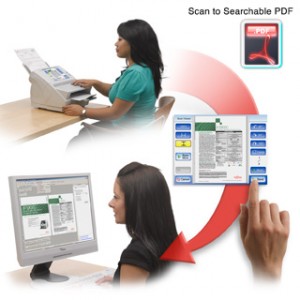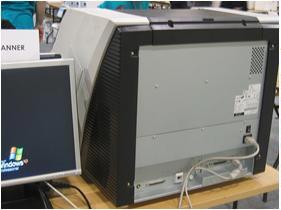Business Solutions, July 2006
According to InfoTrends research, an expected 80% of the growth in the scanning market this year will come from the workgroup segment. This same research suggests that high-volume production scanners will have a flat sales year and may even lose ground in the years to follow. Despite this data, many scanning hardware vendors have quietly enhanced their high-volume devices with new features that move beyond increasing scanning speeds and duty cycles, but focus on enhancing image quality and reducing manual imaging processes. In addition, many high-volume scanners have become more affordable to consumers — a combination that many industry professionals believe will prove the InfoTrends research inaccurate.
“The increased affordability of many high-volume scanners has made them an attractive supplement or alternative to many distributed scanning applications,” says Kevin Neal, product manager for Fujitsu Computer Products of America. “For example, in a distributed deployment, a company may not only need to buy 10 scanners, they may also be required to buy 10 PCs, upgrades and updates to those PCs, and 10 scanning software licenses. Meanwhile, one high-volume production scanner may be able to deliver the same end result at a lower total cost of ownership over time. This scenario illustrates the opportunity for growth that remains in the high-volume segment. Contrary to the InfoTrends research, I believe high-volume scanner sales will gain ground at a modest 5% to 10% over the next few years.”
Image Quality Enhancements Improve Forms Processing
Improved affordability is just one side of the high-volume scanning coin. New features are also adding to the appeal of these devices. One feature that has become standard on most high-volume scanners is the ability of the device to be run at its full-rated speed at 300 dpi (dots per inch) resolution in monochrome, color, or grayscale. “High-volume scanners are primarily used for forms processing applications,” says Neal. “In these environments, image quality is often more important than speed. In the past, if an end user needed to scan a document at 300 dpi or higher to increase OCR [optical character recognition] and ICR [intelligent character recognition] accuracy, the scanner would slow down to a crawl. However, now users can get a high-resolution image without sacrificing speed.”
Other image enhancement features are also being brought onboard many high-volume scanning devices to improve forms processing. Features like autocolor dropout, despeckle, and line removal are all becoming fixtures on high-volume scanners, and all enhance forms processing accuracy. Autocolor dropout is particularly useful in eliminating the red table backgrounds that can often impede OCR read rates on HCFA (Healthcare Financial Administration) claim forms.
High-Volume Scanners Streamline Transaction Processing
Advanced image processing features are being added to high-volume scanners not only to improve forms processing accuracy, they are also helping to eliminate many manual document preparation activities. “Features like autocolor dropout not only improve OCR rates, they prevent the user from having to presort documents based on paper color and reduce the number of times the scanner settings must be adjusted during the imaging process,” says Eric Olsen, product marketing manager for Eastman Kodak Company. “Similarly, an autocolor detect feature automatically switches the scanner to color output mode when a preset level of color content is detected. This reduces the need for presorting and for making image processing changes while scanning.”
Other features that reduce document preparation labor include automatic page rotation and automatic blank page deletion. If the scanner can automatically rotate documents, it eliminates the need for the operator to place all the documents into the feeder in the proper orientation. Likewise, if a scanner can automatically delete blank pages, there is no need to separate single-sided documents from two-sided documents.
Some of today’s high-volume scanners are also incorporating new technologies that use the images they create to streamline transaction processing. “There is a demand for scanning to drive new incremental benefits into a transaction from its point of origination,” says Robert Sbrissa, executive VP of sales and marketing for Imaging Business Machines LLC. “In this case, a transaction is any item that needs further processing beyond archive. This capability demands more intelligence during in-line document processing and requires us to move deeper into the business applications beyond data capture.”
High-volume scanning technologies having an impact on the way a transaction is processed include using the image of the envelope that a document or set of documents was mailed in as a transaction separator. This technology saves customers time and money by eliminating the need to insert bar code separator sheets between batches or individual transactions. Furthermore, it ensures transaction integrity is maintained.
A select few vendors are actually incorporating a platform for document classification with the scanning hardware itself. This technology combines topographic image analysis with business rules to identify the document type (e.g. application, invoice, form). This eliminates the need for an operator to presort documents by type and streamlines transaction processing by accelerating each document through the appropriate workflow.
VARs Must Evolve With New Scanning Trends
With all the new capabilities today’s high-volume scanners provide, getting the appropriate training from your chosen scanner manufacturer is essential. “A VAR is required to master a number of different components to deliver a truly successful imaging solution,” says Neal. “For example, there are thousands of possible scanning hardware and ISIS driver configurations that a VAR can employ to enhance the image quality for its customers’ specific applications. Plus, you need to consider the operating system on the PC, the network, other software integrations, and a number of other variables. You should develop a good relationship with your vendor partners and take advantage of all the training they offer to ensure you have the latest product integration knowledge.”
Understanding the product is important, but perhaps more important is being able to decipher how the scanner addresses your customers’ pain points. “It’s unlikely that your customers are going to ask for most scanner features by name, much less understand why they are important — they will only know what they want the scanner to ultimately do,” says Olsen. “This makes it crucial that VARs effectively align their customers’ needs with the scanners that offer the best features to meet them.”
Finally, with the changing landscape of the scanning industry, VARs must ultimately alter the way they attack the market if they wish to continue to be successful. “Low-cost speeds and feeds are easy to get from a number of vendors,” says Sbrissa. “However, this makes it difficult for VARs or integrators to have a unique differentiator in their solution. Understanding the higher end of this market and moving into more of the transaction processing stream will ensure your solutions have appeal, resulting in higher margins and longer applicability in the market.”
– See more at: http://www.bsminfo.com/doc/High-Volume-Scanners-Up-Their-Game-0001#sthash.6FSgpX81.dpuf








